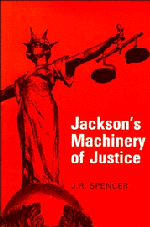Book contents
- Frontmatter
- Contents
- Acknowledgements
- List of figures
- List of tables
- Preface
- Preface to the first edition of ‘The Machinery of Justice in England’
- Abbreviations
- I Historical introduction
- II Civil jurisdiction
- III Tribunals
- IV Criminal jurisdiction
- V The personnel of the law
- VI The European dimension
- VII The cost of the law
- 38 The finances of the law courts
- 39 ‘Costs’
- 40 Legal aid
- 41 Future prospects for legal aid
- VIII Law Reform
- Appendix A The Report of the Civil Justice Review
- Table of Cases cited
- Table of Statutes cited
- Table of Stationery Office publications cited
- Index
41 - Future prospects for legal aid
Published online by Cambridge University Press: 10 January 2011
- Frontmatter
- Contents
- Acknowledgements
- List of figures
- List of tables
- Preface
- Preface to the first edition of ‘The Machinery of Justice in England’
- Abbreviations
- I Historical introduction
- II Civil jurisdiction
- III Tribunals
- IV Criminal jurisdiction
- V The personnel of the law
- VI The European dimension
- VII The cost of the law
- 38 The finances of the law courts
- 39 ‘Costs’
- 40 Legal aid
- 41 Future prospects for legal aid
- VIII Law Reform
- Appendix A The Report of the Civil Justice Review
- Table of Cases cited
- Table of Statutes cited
- Table of Stationery Office publications cited
- Index
Summary
Compared with the dismal arrangements that existed when the first edition of this book appeared in 1940, the schemes for legal aid that we have today represent a magnificent achievement. However, the system is beset by problems on all sides and few people are satisfied with it. From the consumer's point of view the provision for legal aid is inadequate in a number of important respects. The schemes are centred firmly on the law courts, and there is little help for cases in tribunals, important as these are. For civil cases in the law courts there is the notorious ‘middle-class poverty trap’ already mentioned, which puts High Court proceedings out of the reach of many people who are too rich to qualify for civil legal aid but too poor to pay for litigation. For these reasons, one of the few radical proposals to come from the Benson Commission was that there should be a great increase in the scope of legal aid. From the point of view of the government, which has to find the money to pay for legal aid, the problem is that it is expensive, and the cost of it all has been rising rapidly. The total legal aid bill, which for England and Wales was some £100 million in the year 1979/80, is likely to be around £400 million for 1986/7.
- Type
- Chapter
- Information
- Jackson's Machinery of Justice , pp. 482 - 490Publisher: Cambridge University PressPrint publication year: 1989

